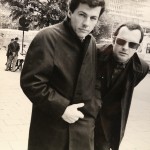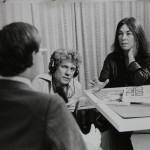 James Blue (1930-1980) was known internationally for being a groundbreaking filmmaker and documentarian as well as an educator, an actor, an avid film historian, and an advocate of experimentation in the non-fiction form. Blue influenced a generation of media makers and worked tirelessly to promote the craft of telling true stories with moving images.
James Blue (1930-1980) was known internationally for being a groundbreaking filmmaker and documentarian as well as an educator, an actor, an avid film historian, and an advocate of experimentation in the non-fiction form. Blue influenced a generation of media makers and worked tirelessly to promote the craft of telling true stories with moving images.
James Blue made documentary and fiction films throughout his life. Moving in1942 to Oregon from Oklahoma with his parents and younger brother, Richard Blue, James graduated from Portland’s Jefferson High School and received a BA from the University of Oregon in Speech and Theater in 1953. He achieved local fame with his activities in radio, theater, and film production (including an 8mm Hamlet parody seen by over 2,000 UO students and a western spoof called The Silver Spur). After two years, of Army service, he returned to UO for a Masters in Theater Arts, then left after receiving a scholarship to complete his studies at the prestigious Institut des hautes études cinématographiques (IDHEC) in Paris from 1956-58. There, he took classes with Jean Mitry and Georges Sadoul and alongside fellow students Costa-Gavras, Johan van der Keuken, and James Dormeyer.
His first documentary and feature length non-fiction films were made in Algiers during the war for Algerian independence. Blue used both professional and untrained actors and a highly realistic presentational style. Les Oliviers de la Justice (The Olive Trees of Justice) was a sensation at the 1962 Cannes Film Festival, where it was shown in the inaugural Semaine de la Critique, and earned Blue the Prix de la Société des Écrivains de Cinéma et Télévision au Festival de Cannes.
Back in the U.S., he made five documentary films for the United States Information Agency. The most well-known of these, The March [The March to Washington, 1963-64], presents the largest demonstration in American history: the black civil rights movement’s protest march in 1963, culminating with Martin Luther King’s famous speech. The March was named to the National Film Registry in 2008 and was preserved by the National Archives in 2013. Another USIA film, cited by Thom Andersen as a pioneering work in the essayistic documentary mode, A Few Notes on Our Food Problem (1968), earned Blue an Academy Award nomination for Best Documentary Feature.
 As an educator he taught at UCLA and in the first classes offered by the American Film Institute, and among his students in Los Angeles were Terrence Malick, Paul Schrader, Joan Churchill, and Jim Morrison. He established the still vibrant Southwest Alternate Media Project (SWAMP) in Houston, Texas, taught and lectured on film at Yale University, the Museum of Modern Art (MOMA) in New York, the British Film Institute, and was a faculty member at the State University of New York’s Buffalo media study program.
As an educator he taught at UCLA and in the first classes offered by the American Film Institute, and among his students in Los Angeles were Terrence Malick, Paul Schrader, Joan Churchill, and Jim Morrison. He established the still vibrant Southwest Alternate Media Project (SWAMP) in Houston, Texas, taught and lectured on film at Yale University, the Museum of Modern Art (MOMA) in New York, the British Film Institute, and was a faculty member at the State University of New York’s Buffalo media study program.
He continued to make ethnographic and urban focused films and videos. In 1974, Blue went to Africa to co-direct and take sound for Kenya Boran with his colleague at Rice University, David MacDougall. Their new style of observational cinema involved single shots of unusually long duration and invited the subjects being filmed to participate in the making.
The urban videos (Who Killed 4th Ward? and Invisible City, the latter made together with architect Adele Santos) were about the effects of development and corresponding powerlessness of the poor to resist. In particular the multipartite documentary The Invisible City was conceived as a televised dialogue: its public could express themselves regarding its subject, and influence the concluding film.
Blue believed in the “democratization” of media access and production. He championed the use of inexpensive film and video production technology that could be used by “non-professionals” to tell their stories. At SWAMP he helped train young people from poor neighborhoods in the art and craft of making films about the stories that shaped their lives. Blue did not just want to present problems, he wanted to make the powerful media of television and film accessible to a broad public, and strengthen their sense of responsibility. His influential ideas with respect to documentary film were passed on, beginning in 1967 as the Director of the Media Center at Rice University in Houston, and then from 1977 onwards in the Department of Media Study at SUNY, Buffalo.
Turning his energy toward film history, James Blue did extensive interviews with leading international film directors, many of which were published in the magazine, Film Comment. James Blue received the first grant ever given to a filmmaker by The Ford Foundation (1964). His proposal was to record and film interviews with the international directors who were beginning to use non-actors in their works, as he himself had done in Les Oliviers de la Justice. These included Roberto Rossellini and Federico Fellini in Italy, Jean-Luc Godard and others in France, Milos Forman and Ivan Passer in Czechoslovakia, and Satyajit Ray in India. He also interviewed international practitioners of “cinema verite” and makers of the American documentary classics of the 1930s and 1940s. In all, Blue did more than 75 interviews, many more than two hours long, later including Jean Renoir, Alfred Hitchcock, Robert Bresson, Frank Capra, and King Vidor. Gerald O’Grady describes this archive of recorded interviews as “one of the most important film history projects of the second half of the 20th century.”
Blue died suddenly of cancer in 1980, having accomplished all of these things before reaching his 50th birthday.
(We wish to thank Gerald O’Grady and Richard Blue, from whose writings on Blue the above has been liberally drawn).



